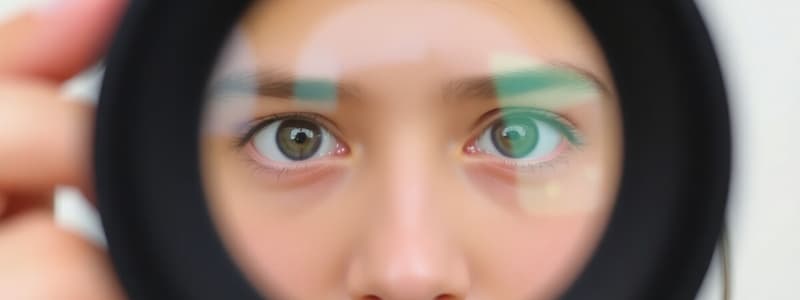Podcast
Questions and Answers
What is the main reason for blurry vision in myopia?
What is the main reason for blurry vision in myopia?
- Light is focused beyond the retina.
- The lens cannot focus light on the retina.
- Light gets focused on a single point before the retina. (correct)
- The curvature of the cornea is too steep.
How is hypermetropia primarily corrected?
How is hypermetropia primarily corrected?
- With a concave lens.
- With reading glasses.
- With cylindrical lenses.
- With a convex lens. (correct)
Which type of lens is specifically used to correct astigmatism?
Which type of lens is specifically used to correct astigmatism?
- Concave lens.
- Cylindrical lens. (correct)
- Bifocal lens.
- Convex lens.
What is the main characteristic of presbyopia?
What is the main characteristic of presbyopia?
Which statement is true regarding contact lenses for astigmatism?
Which statement is true regarding contact lenses for astigmatism?
Flashcards
Myopia
Myopia
Nearsightedness. Difficulty seeing objects in the distance, but clear vision for near objects. Light focuses in front of the retina.
Hypermetropia
Hypermetropia
Farsightedness. Difficulty seeing near objects, but clear vision for far objects. Light focuses behind the retina.
Astigmatism
Astigmatism
A distorted cornea shape leading to uneven focusing of light. Vision is blurry at all distances. The cornea is curved abnormally causing light to focus on multiple points.
Presbyopia
Presbyopia
Signup and view all the flashcards
What type of lens corrects astigmatism?
What type of lens corrects astigmatism?
Signup and view all the flashcards
Study Notes
Refractive Errors
-
Myopia (Nearsightedness):
- Lens after 40, start seeing well due to presbyopia
- Blurry vision far, clear near
- Light focuses in front of retina
- Corrected with concave lens
- Myopia with astigmatism can be treated with laser eye surgery (LASIK)
-
Hypermetropia (Farsightedness):
- Lens after 40, reach presbyopia early
- Blurry vision near, clear far
- Light focuses behind the retina
- Corrected with convex lens
-
Astigmatism:
- Abnormal cornea shape
- Refractive power varies across cornea
- Light doesn't focus on a single point
- Corrected with cylindrical lenses
- Types: Myopic, Hypermetropic, Combined (one axis myopic, the other hypermetropic)
- High astigmatism: treated with contact lenses
-
Presbyopia:
- Age-related
- Impaired accommodation (eye can't adjust focus) due to decreased lens elasticity
- Can't focus on near objects
- Corrected with reading glasses
Lens Types
- Sphere lenses: For myopia and hypermetropia
- Cylinder lenses: For astigmatism (axis 180-190 degrees)
- Contact Lenses:
- Hard and soft
- Permeable
- Hard lenses used for keratoconus (abnormal cornea shape) to flatten it
Studying That Suits You
Use AI to generate personalized quizzes and flashcards to suit your learning preferences.



